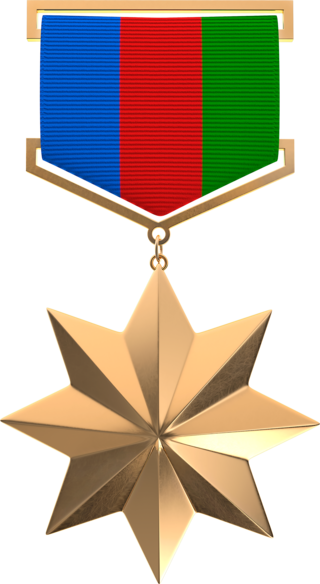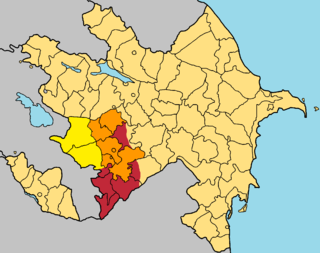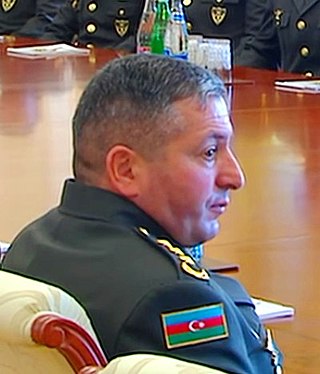June incident
The incident occurred near the village of Chayli, located in the province of Mardakert/Tartar in Nagorno-Karabakh on June 18–19. Warrant officer Mubariz Ibrahimov, wrote a letter at around 11.30 PM on June 18, 2010, [6] and started to move towards the Nagorno-Karabakh Line of Contact without informing anyone in the unit he was serving in. With the darkness of the night and his camouflage, he passed through a kilometer (0.62 mi) mined area alone and raided the Armenian military outpost in the then-occupied Chayli village of Terter region. [8] [9] Here, Ibrahimov fought the Armenian forces for five hours using the ammunition at the military station and died around 5 AM. [8] According to numerous sources, he killed 45 [8] [10] [11] [12] or 140 [14] Armenian soldiers. Vladimir Putin had said in a speech that Ibrahimov had fought and killed 135 Armenian soldiers. [15] However, according to the Armenian Government, Ibrahimov killed 4 Armenian soldiers [16] and injured 4. [17]
Mübariz's father said that when it was understood that Mübariz was missing from his unit, he received a call early in the morning about the incident and was asked whether his son had come home and that he had taken many weapons and ammunition and left the unit he was stationed in. His father said this in his answer: "I know my son, go towards the border." [18]
In the letter of Ibrahimov wrote before leaving his unit and attacking the Armenian Outpost he wrote:
Letter to my father and mother. My dear father and mother. Do not worry about me. Hopefully we will meet in heaven. Pray a lot for me. My heart can no longer bear the difficult days of my homeland. I have to do this for God's sake. At least my heart will calm down. I hope I will go against these dishonorable people until I become a martyr. If I become a martyr, do not cry, on the contrary, be happy that I have risen to that level. Do not neglect your worship to Allah. Give lots of charity.
As one of the descendants of the prophet, I must do this.
Allah is great. Thank you homeland.
Forgive your rights.
Your son, Mubariz.
İbrahimov Mübariz [19] [20]
According to the Defense Ministry of the Nagorno-Karabakh Republic, The Armenian Outpost near Chayli came under a surprise attack by a Azerbaijani sabotage unit at about 11:30 PM on June 18 [21] [22] and the body of Azerbaijani Warrant Officer Mubariz Ibrahimov was found dead inside the Armenian Military Outpost in Chayli. [2] Armenian forces retaliated the next day by launching an attack near Fizuli on June 20–21, killing one Azerbaijani serviceman. [5] Azerbaijani forces claimed to have repelled the attack and inflicted further casualties on the Armenians.
In the Second Nagorno-Karabakh War, The Azerbaijani Military captured the Armenian outpost Mubariz was killed in and erected the Azerbaijani Flag [23]
Military analysis
Richard Giragosian, the director of the Armenian Center for National and International Studies and a former defense analyst for Jane's , described the intrusion as "either a test on Armenian response or a sign of lack of command and discipline in the Azerbaijani military." [24] He described it as "more professional and more deadly than previous such incursions" and had been planned days in advance. [5] The fact that the attack began with an Azerbaijani sniper inflicting a fatal head wound on an Armenian soldier was further evidence of this, he said. [5]

Kalbajar District is one of the 66 districts of Azerbaijan. It is located in the west of the country and belongs to the East Zangezur Economic Region. The district borders the districts of Lachin, Khojaly, Agdam, Tartar, Goranboy, Goygol and Dashkasan districts of Azerbaijan, as well as the Gegharkunik and Vayots Dzor provinces of Armenia. Its capital and largest city is Kalbajar. As of 2020, the district had a nominal population of 94,100.

The First Nagorno-Karabakh War was an ethnic and territorial conflict that took place from February 1988 to May 1994, in the enclave of Nagorno-Karabakh in southwestern Azerbaijan, between the majority ethnic Armenians of Nagorno-Karabakh backed by Armenia, and the Republic of Azerbaijan with support from Turkey. As the war progressed, Armenia and Azerbaijan, both former Soviet republics, entangled themselves in protracted, undeclared mountain warfare in the mountainous heights of Karabakh as Azerbaijan attempted to curb the secessionist movement in Nagorno-Karabakh.

The Nagorno-Karabakh conflict is an ethnic and territorial conflict between Armenia and Azerbaijan over the region of Nagorno-Karabakh, inhabited mostly by ethnic Armenians until 2023, and seven surrounding districts, inhabited mostly by Azerbaijanis until their expulsion during the 1990s. The Nagorno-Karabakh region was entirely claimed by and partially controlled by the breakaway Republic of Artsakh, but was recognized internationally as part of Azerbaijan. Azerbaijan gradually re-established control over Nagorno-Karabakh region and the seven surrounding districts.

The National Hero of Azerbaijan is the highest national title in the Republic of Azerbaijan. The title was named on 25 March 1992, and the "Qizil Ulduz" Medal awarded as a sign of receiving this title was established by a separate law on 15 July 1992. The law on the title has been in effect since 25 December 1995. It can only be awarded once to the same person.

There are no diplomatic relations between Armenia and Azerbaijan. The two neighboring states had formal governmental relations between 1918 and 1921, during their brief independence from the collapsed Russian Empire, as the First Republic of Armenia and the Democratic Republic of Azerbaijan; these relations existed from the period after the Russian Revolution until they were occupied and annexed by the Soviet Union, becoming the constituent republics of Soviet Armenia and Soviet Azerbaijan. Due to the five wars waged by the countries in the past century—one from 1918 to 1921, another from 1988 to 1994, and the most recent in 2016, 2020 and 2023—the two have had strained relations. In the wake of hostilities, social memory of Soviet-era cohabitation is widely repressed through censorship and stigmatization.

Aghdam is a ghost city and the nominal capital of the Aghdam District of Azerbaijan. Founded in the 18th century, it was granted city status in 1828 and grew considerably during the Soviet period. Aghdam lies 26 km from Stepanakert at the eastern foot of the Karabakh Range, on the outskirts of the Karabakh plain.

The 2008 Mardakert clashes began on March 4 after the 2008 Armenian election protests. It involved the heaviest fighting between ethnic Armenian and Azerbaijani forces over the disputed region of Nagorno-Karabakh since the 1994 ceasefire after the First Nagorno-Karabakh War.
Mubariz Aghakerim oğlu Ibrahimov was an Azerbaijani Warrant Officer and National Hero of Azerbaijan.
The 2010 Nahorno karabakh war were a series of exchanges of gunfire that took place on February 18 on the line of contact dividing Azerbaijani and the Karabakh Armenian military forces. Azerbaijan accused the Armenian forces of firing on the Azerbaijani positions near Tap Qaraqoyunlu, Qızıloba, Qapanlı, Yusifcanlı and Cavahirli villages, as well as in uplands of Agdam Rayon with small arms fire including snipers. As a result, three Azerbaijani soldiers were killed and one wounded.

The Madrid Principles were proposed peace settlements of the Nagorno-Karabakh conflict, proposed by the OSCE Minsk Group. The OSCE Minsk Group was the only internationally agreed body to mediate the negotiations for the peaceful resolution of the conflict prior to the renewed outbreak of hostilities in 2020. Senior Armenian and Azerbaijani officials had agreed on some of the proposed principles but made little or no progress towards the withdrawal of Armenian forces from occupied territories or towards the modalities of the decision on the future Nagorno-Karabakh status.

United Nations General Assembly Resolution 62/243, titled "The Situation in the Occupied Territories of Azerbaijan", is a resolution of the United Nations General Assembly about the situation in Nagorno-Karabakh, which was adopted on March 14, 2008 at the 62nd session of the General Assembly. It became the seventh United Nations document concerning Nagorno-Karabakh and the third and last United Nations General Assembly document on it.
Organisation of the Islamic Conference Resolution 10/11, titled "The aggression of the Republic of Armenia against the Republic of Azerbaijan", is an Organisation of the Islamic Conference Resolution on Nagorno-Karabakh conflict adopted by its member states on March 13–14, 2008 during the OIC summit in Dakar, Senegal. The resolution, titled "Aggression by the Republic of Armenia against the Republic of Azerbaijan," aims to express concern over Armenia's aggression against Azerbaijan and to provide comprehensive support for the territorial integrity of the Republic of Azerbaijan. The Dakar conference is considered a "successful step" towards supporting Azerbaijan's just cause. It was during this session that the new Charter of the Islamic Cooperation Organization was adopted, and in the section on the purposes and objectives of this international organization, it was stipulated that the member states support the right of states under occupation to restore their territorial integrity.

The 2012 border clashes between the armed forces of Armenia and Azerbaijan took place in early June. The clashes resulted in casualties on both sides.

Clashes on the Armenian–Azerbaijan border (Tavush–Qazakh) and the line of contact between the Nagorno-Karabakh and Azerbaijan started on 27 July 2014. Reported casualties of the clashes were some of the highest since the 1994 ceasefire agreement that ended the First Nagorno-Karabakh War.

The 2016 Nagorno-Karabakh conflict, also known as the Four-Day War, April War, or April clashes, began along the former Nagorno-Karabakh line of contact on 1 April 2016 with the Artsakh Defence Army, backed by the Armenian Armed Forces, on one side and the Azerbaijani Armed Forces on the other.

Shukur Nariman oğlu Hamidov was an Azerbaijani officer, national hero and colonel of the Armed Forces of Azerbaijan. He was son to Nariman and Shargiya Hamidov. He was an enlisted member of the army since a young age and had experienced multiple wars. His family were refugees from Armenia that later migrated to Azerbaijan.
The 2020 Azerbaijani protests, also known within Azerbaijan as the Karabakh March, were series of civil protests from 12 to 15 July in various cities and towns in Azerbaijan. They erupted during the Armenian–Azerbaijani border clashes, with the protestors demanding full-scale war with Armenia over the Nagorno-Karabakh conflict.

The military forces of Armenia and Azerbaijan have been engaged in a border conflict since 12 May 2021, when Azerbaijani soldiers crossed several kilometers into Armenia in the provinces of Syunik and Gegharkunik. Despite international calls for withdrawal from the European Parliament, the United States, and France, Azerbaijan has maintained its presence on Armenian soil, occupying at least 215 square kilometres (83 sq mi) of internationally recognized Armenian territory. This occupation follows a pattern of Azerbaijan provoking cross-border fights and instigating ceasefire violations when its government is unhappy with the pace of negotiations with Armenia.
The Susuzluq explosion was a mine explosion in the vicinity of the village of Susuzluq in Azerbaijan's Kalbajar region, which occurred on 4 June 2021. The explosion killed 3 people, two of them journalists, and wounded another 4. This is the first case of journalist death on Azerbaijani territory after the 2020 Nagorno-Karabakh war.
Events of the year 2023 in Armenia.











